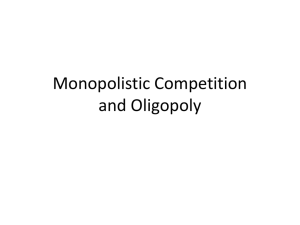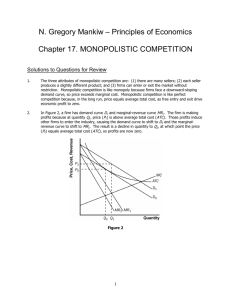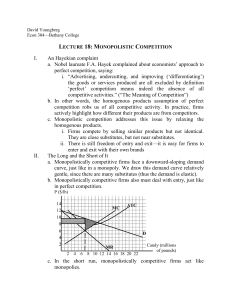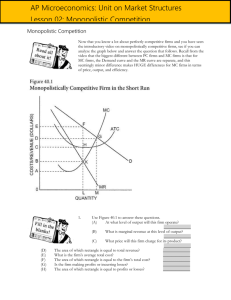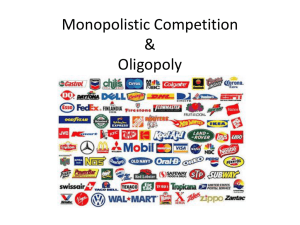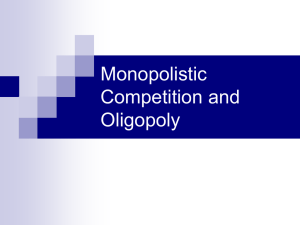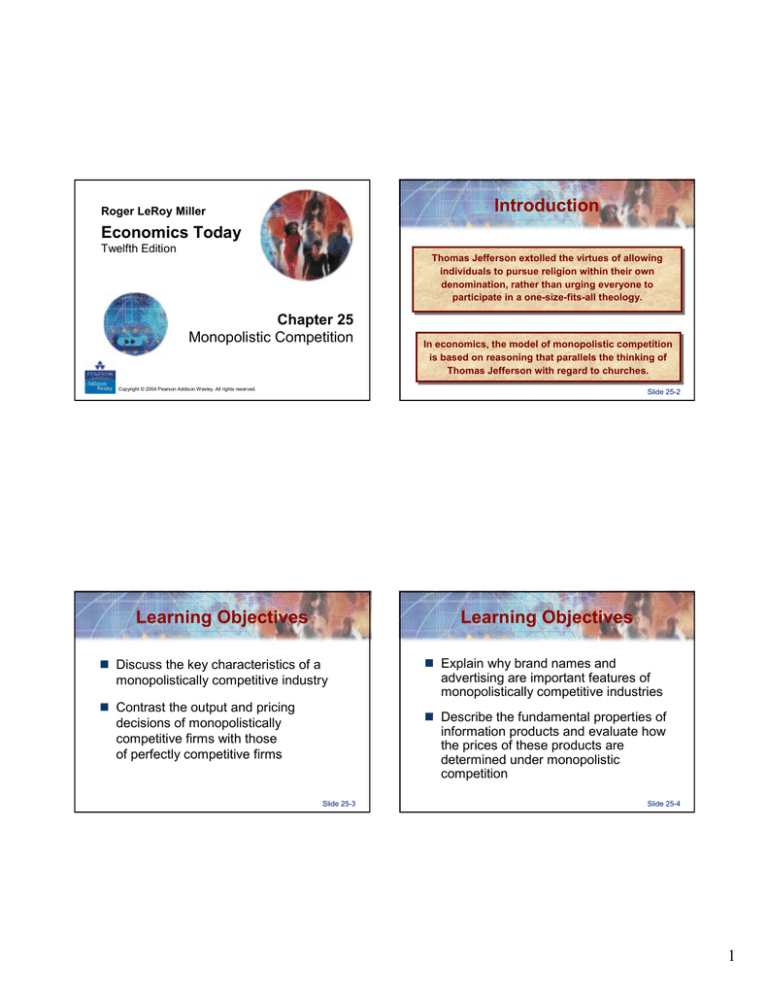
Introduction
Roger LeRoy Miller
Economics Today
Twelfth Edition
Thomas Jefferson extolled the virtues of allowing
individuals to pursue religion within their own
denomination, rather than urging everyone to
participate in a one-size-fits-all theology.
Chapter 25
Monopolistic Competition
In economics, the model of monopolistic competition
is based on reasoning that parallels the thinking of
Thomas Jefferson with regard to churches.
Copyright © 2004 Pearson Addison Wesley. All rights reserved.
Slide 25-2
Learning Objectives
Learning Objectives
Discuss the key characteristics of a
monopolistically competitive industry
Contrast the output and pricing
decisions of monopolistically
competitive firms with those
of perfectly competitive firms
Explain why brand names and
advertising are important features of
monopolistically competitive industries
Describe the fundamental properties of
information products and evaluate how
the prices of these products are
determined under monopolistic
competition
Slide 25-3
Slide 25-4
1
Chapter Outline
Did You Know That...
Monopolistic Competition
Elementary school students are the
age group of Internet users most likely
to click on banner ads?
Price and Output in Monopolistic
Competition
Comparing Perfect Competition
with Monopolistic Competition
Internet advertisers are trying to
determine how to increase the click
ratio for everyone using the Web?
Brand Names and Advertising
Information Products and Monopolistic
Competition
Slide 25-5
Monopolistic Competition
Monopolistic Competition
– A market situation in which a large
number of firms produce similar but not
identical products
– Entry into the industry is relatively easy
Slide 25-6
Monopolistic Competition
Characteristics of monopolistic
competition
– Significant number of sellers in a highly
competitive market
– Differentiated products
– Sales promotion and advertising
– Easy entry of new firms in the long run
Slide 25-7
Slide 25-8
2
Monopolistic Competition
Implications of the large number of
firms
Monopolistic Competition
Product Differentiation
– The distinguishing of products by brand
name, color, and other minor attributes
– Small market share
– Lack of collusion
– Independence
Slide 25-9
Monopolistic Competition
Product differentiation and price
Slide 25-10
Monopolistic Competition
Ease of entry
– Differentiate perfectly
– Threat of a more efficient competitor is
always present
• Producer is a monopoly
– Significant influence on price
– Differentiation is not perfect
• Producer is a monopolistic competitor
– The more successful it is at differentiation,
the more control it has over price
Slide 25-11
Slide 25-12
3
Monopolistic Competition
Sales promotion and advertising
Monopolistic Competition
Advertising as signaling behavior
– Can increase demand for a firm
– Advertising over a long period of time is a
signal that a firm wants repeat business
– Can differentiate a firm’s product
– Should be continued to the point at which
the additional revenue from one more
dollar of advertising just equals that one
dollar of marginal cost
Slide 25-13
Monopolistic Competition
Slide 25-14
Short-Run and Long-Run
Equilibrium with Monopolistic
Competition
Panel (a)
What do you think?
MC
– Why would a monopolistically
competitive firm advertise?
ATC
Dollars per Unit
– Would a perfect competitor have any
incentive to advertise?
P
d
ATC
Profits
• Price (P1) > ATC
• Economic profit
A
MR
– Can advertising lead to efficiency?
q
Quantity
Slide 25-15
Figure 25-1, Panel (a)
Slide 25-16
4
Price and Output in
Monopolistic Competition
Short-Run and Long-Run
Equilibrium with Monopolistic Competition
Panel (c)
Panel (b)
ATC
MC
Dollars per Unit
Dollars per Unit
MC
ATC
P
d
Losses
A
-Price (P1) < ATC
-Economic loss
ATC
T
P=
ATC
d
A
MR
-Price (P1) = ATC
-Normal rate of return
MR
q
q
Quantity
Slide 25-17
Comparing Perfect Competition
with Monopolistic Competition
Comparison of the Perfect Competitor
with the Monopolistic Competitor
Panel (a)
Perfect Competition
MC
Perfect competitors and monopolistic
competitors earn zero economic profit.
Panel (b)
Monopolistic Competition
d
P1
MR = P
ATC
MC
ATC
Minimum ATC
Dollars per Unit
How are they different?
Slide 25-18
Figure 25-1, Panel (c)
Minimum ATC
Dollars per Unit
Figure 25-1, Panel (b)
Quantity
P2
d
MR
q1
Quantity per Time Period
Slide 25-19
Figure 25-2, Panels (a) and (b)
q2
Quantity per Time Period
Slide 25-20
5
Comparing Perfect Competition
with Monopolistic Competition
What do you think?
Brand Names
Firms use trademarks, words, symbols,
and logos to distinguish their product
brands from goods or services sold by
other firms
– Would you want to live in a perfectly
competitive world with homogenous
products?
A successful brand image contributes
to a firm’s profitability
Slide 25-21
Advertising
Slide 25-22
Advertising
Forms of advertising
Search goods have characteristics that can
be evaluated prior to purchase
– Direct marketing
Experience goods, such as movies and
haircuts, don’t fully reveal their value until
they have been consumed
– Mass marketing
– Interactive marketing
Advertising for experience goods is more
likely to be persuasive rather than
informational
Slide 25-23
Slide 25-24
6
Information Products
and Monopolistic Competition
Cost Curves for
Information Products
Information products, such as
computer operating systems, software,
and digital music and videos, have a
unique cost structure
Product development entails high fixed
costs, but the marginal cost of
producing a copy for one more
customer is low
Slide 25-25
Cost Curves
for Information Products
Slide 25-26
Monopolistic Competition and
Information Products
Sellers of information products
experience short-run economies of
scale.
Computer game manufacturers
operate in a monopolistically
competitive market
The average total cost continually
declines as quantity increases.
In monopolistic competition, marginal
cost pricing results in losses for the
firm
Slide 25-27
Slide 25-28
7
Infeasibility of Marginal Cost Pricing
of an Information Product
Pricing for Information Products
In the long-run, price will equal average total cost.
This yields the long-run equilibrium condition of zero
economic profit.
Firms selling information products in a
monopolistically competitive industry will recover all
their production costs.
Customers will pay more than marginal cost, but
they will pay the minimum price necessary to call
forth the product to market.
Slide 25-29
Issues and Applications: U.S.
Churches Differentiate Their
Products
Membership in mainline Protestant
denominations has declined as distinctions
between denominations have blurred.
Denominations are now trying to highlight
their unique characteristics in promotional
campaigns, thereby achieving some degree
of product differentiation.
Slide 25-31
Slide 25-30
Web Links
The following Web link appears in the
margin of this chapter in the textbook:
– http://www.csgb.ubc.ca/ccpp/simulation
Slide 25-32
8
Summary Discussion
of Learning Objectives
Summary Discussion
of Learning Objectives
Contrasting the output and pricing
decisions of monopolistically
competitive firms with those of
perfectly competitive firms
Key characteristics of monopolistic
competition
– Large number of small firms
– Differentiated products
– Monopolistically competitive firm
•
•
•
•
– Easy entry and exit
– Advertising and sales promotion
MR = MC determines output
Price set on demand curve
P > MC
P = ATC in the long run
Slide 25-33
Slide 25-34
Summary Discussion
of Learning Objectives
Summary Discussion
of Learning Objectives
Monopolistically competitive firms
attempt to boost demand for their
products through product differentiation
In long-run equilibrium, the provider of
an information product in a
monopolistically competitive industry
will sell the product for a price equal to
average total cost
Providing an information product
entails incurring relatively high fixed
costs but low marginal costs
Slide 25-35
Slide 25-36
9
End of Chapter
Chapter 25
Monopolistic Competition
Copyright © 2004 Pearson Addison Wesley. All rights reserved.
10

